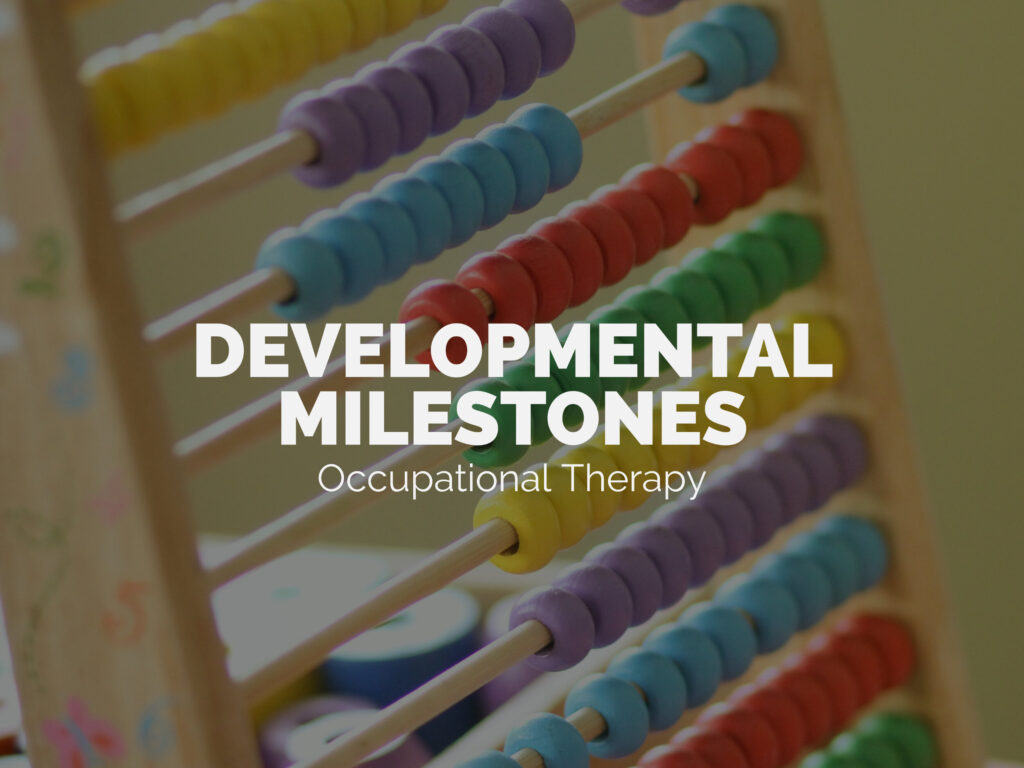
Rachel Morris, OTR/L, Director of Therapy
Every parent desires for their child(ren) to be happy, healthy and reach their full potential, moving toward independence in everyday activities. Development of independence tends to be sequential, developing skills in a particular order that build on each other. This sequence of development is known as milestones.
What are Developmental Milestones?
As an infant grows into a child, their senses develop and motor skills expand so that they can interact with people and objects around them. From learning to reach out, to grasping and fingering an object, to using tools like a spoon, crayon, or scissors, a child becomes increasingly independent.
Many components like motor development and sensory processing can impact a child’s ability to actively engage in everyday activities and self-care skills. Take for example, sensory processing. Sensory processing is the ability to take in and make sense of information from the environment such as sounds, sights, touch, and movement. Sensory processing impacts how a child experiences, understands, and responds to the surroundings and situation. If a child is aversive to textures like food or clothing, they may avoid performing certain activities like dressing or eating. If the child is sensory craving, he/she may be constantly moving, fidgeting and touching things around them in order to receive sensory input.
Typically, children develop milestones around the same ages. Monitoring milestones can give insight into your child’s skill level and may help to identify any potential concerns. However, please note, each child is unique and may progress at a different rate or even skip a milestone all together.
If you have concerns about your child’s development or sensory processing, visit our therapy services page or contact us to see if your child might benefit from therapy.
Typical Milestones by Age
3 Months
-
Follows an object that is moving with eyes
-
Responds and turns head to loud sounds
-
Opens and closes hand, hold and shake an object
-
Brings hands to mouth
6 Months
-
Reaches for toy with only one arm/hand
-
Holds a toy or object in each hand
-
Transfers a toy or object from one hand to the other
-
Starts to sit without support
9 Months
-
Maintains balance in sitting when moving arms/hands to reach a toy
-
Picks up smaller objects between fingers and opposed thumb
-
Get into a sitting position
-
Holds own bottle
12 Months
-
Finger-feeds small food items, increase variety of food
-
Points with index finger; Pokes and probes objects with just the index finger
-
Imitates a scribble
-
Imitates simple gestures like waving bye, shaking head, or clapping
18 Months
-
Drinks from a cup and eats with a spoon
-
Helps to undress self
-
Knows what common objects are used for (ie talking on the phone or using brush on hair)
-
Scribbles independently
2 Years
-
Imitates drawing a vertical line and makes circular scribbles
-
Builds a tower with four or more cubes
-
May start to show a preference in hand use (but not always)
-
Turns a single page in a book
3 Years
-
Opens door knobs and unscrews lids
-
Snips with scissors
-
Draws a horizontal line, a single circle and imitates drawing a cross (+) pattern
-
Completes a 3 to 4 piece puzzle
4 Years
-
Dresses self with some assistance with fasteners and tying shoes
-
Uses scissors to cut on a line
-
Holds a pencil between the thumb and index finger like an adult
-
Draw a simple person with at least 2-4 parts
5 Years
-
Learns to fasten buttons and zip a coat
-
Uses toilet without assistance
-
Cuts out simple shapes like a circle or square with scissors
-
Colors a shape within the lines, draws a recognizable person, and copies some shapes and letters
Our providers are knowledgeable and gifted at working with kids of all ages and abilities. Enablr Therapy provides physical, occupational, and speech therapy services to help people to all ages and abilities. We provide in-person and live-video therapy sessions for clients throughout the state of Tennessee and select states.
To learn more how Enablr Therapy works with kids,visit our therapy services page.
These milestones were developed with use of the references below and also based on the clinical knowledge.
References:
American Academy of Pediatrics (n.d.) Ages and Stages. Retrieved from https://healthychildren.org/english/ages-stages/pages/default.aspx
Center for Disease Control (n.d.). Milestone Checklist. Retrieved from https://www.cdc.gov/ncbddd/actearly/pdf/checklists/Checklists-with-Tips_Reader_508.pdf
Peabody Motor Developmental Chart (2002). Published by Pro-Ed.


